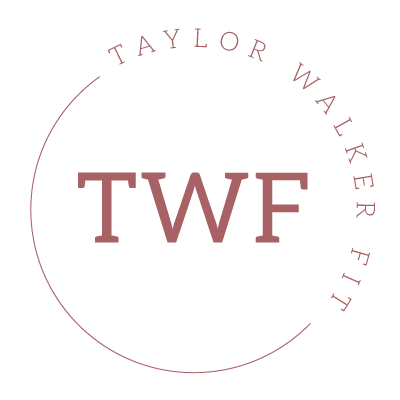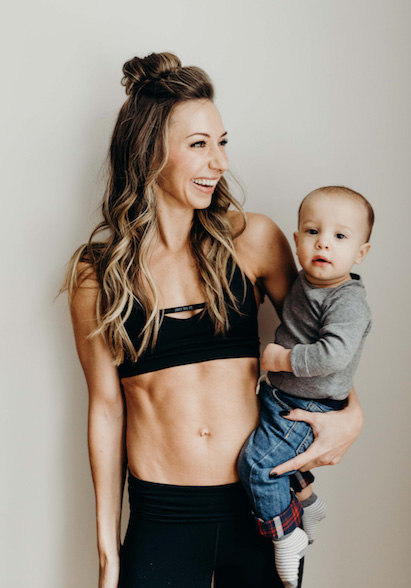Congratulations, ma! You did it. You birthed, what is no doubt, the most perfect and incredible baby to ever grace God’s green earth.
If your experience is anything like mine, you’re most likely sitting on your couch like a deer in headlights. Maybe you’re freaking the fahk out. You’re probably pumping while eating with one hand and holding your baby in the other. You’re questioning whether or not you’re fit to be a mom, crying because you’re happy, crying because you’re scared, wondering if you’ll ever leave the house again!
BUT EVERYTHING IS FINE!
And it is, truly. It gets so much better. You get better. And you’ve got this.
The itch to move your body happens at different points in the post-partum journey for every woman, but for most I’ve come across, it happens almost right away.
But just because you feel READY for postpartum fitness, doesn’t mean you are – physiologically speaking.
The below is a guideline for the general post-natal population based off of my experience, education, and current research. These guidelines will vary depending on your delivery and progress of recovery.
If you experienced a traumatic birth, your timeline might differ. ALWAYS check with your doctor to make sure your actions align with your current condition.
As ALWAYS, there is fine print! This is by no means the beginning or the end of postpartum fitness – you have to do what you feel comfortable with, and you ALWAYS have to evaluate your current situation.
Your Postpartum Re-Entry Fitness Guide
Week 1 Postpartum: Heal
Chill. The. Fahk. Out. When I hear women say they were at the gym four days/one week/two weeks after giving birth I question their level of sanity. I would apologize for saying that – but I’m not sorry!
Your body has GOT to heal whether you like it or not. If you rush, there is a GOOD chance you will incur consequences, injury, setback, pain, discomfort, etc., and why would you want that when all your energy and focus is going towards the wellbeing of a tiny little one?
Simply put, you can’t afford a setback.
I mean, think about it. Your organs are out of place, tissue is SENSITIVE and tender, and your center of gravity is on the move. Muscles that have laid dormant for MONTHS are being shocked back into use. Do I need to say more?
Rest when you can, sleep, snuggle with your baby. You’ll be off to your grind soon enough, and these are precious hours you can never have back.
Savor them.
Week 2-5 Postpartum: Engage
Connect your breath to your body – literally.
-
- Slow, flat walks for approximately, 20-30 minutes
- Diaphragmatic breathing, 10 minutes a day, twice a day
Your body will tell you if you’re doing too much, too soon right away. Even an aggressive walk can leave you with inflammation, soreness, or tenderness.
Diaphragmatic breath work is the starting point to heal your diastasis and strengthen your abdominals by re-establishing the connection between your diaphragm, abdominal cannister, and pelvic floor.
To be clear, all three need to be functioning correctly, and in good health for any of the following to ring true.
How to do it:
-
- Select a starting position, and I like to lay down with my feet flat, knees up, and a pillow between my knees to engage my adductors/inner thighs. You can also sit up but make sure your posture is upright, your hips are square, and your feet are flat on the floor.
-
- Take a deep inhale, and visualize your lungs expanding to the sides while your belly fills with air and “hangs.”
- Lightly purse your lips and exhale sharply and steadily through your mouth. Make an audible “shhhhh” noise. As you exhale, CONTRACT your abs. Here’s the hard part – CONTRACTION is different than SUCKING IN.
Don’t think about this as bringing your “belly button to spine” but rather flattening, tightening, and lifting. If you experience a bulge or ridge in your belly, either down the center of your abs or underneath your belly button, you’re exhaling too hard and sucking in.
Additionally, visualize your pelvic floor zipping upward to mimic the lift you feel throughout the abs. Less lift through the glutes, and more lift through the inner vaginal wall.
Week 6-13: Rehab and Rebuild
In the U.S. it’s the standard of care to receive a 6-week postpartum checkup to make sure your body is healing properly. Your check-up may differ depending on your type of delivery, and level of trauma.
Regardless, your examination will NOT include a pelvic floor or abdominal evaluation, which is unfortunate since that system is mostly what dictates readiness to return to fitness after having a baby. Diastasis Recti, or abdominal separation, is inevitable during pregnancy. I’ve read publications that claim “60% of women’s diastasis will heal on its own,” and I gotta say, I just don’t believe that.
In my opinion, SOME form of abdominal and pelvic floor rehab is absolutely needed in order to set yourself up for the most success as you re-enter the gym as a postpartum woman.
Continue to do your:
- Diaphragmatic breathing
Introduce:
-
- Abdominal rehab
-
- Pelvic floor rehab
-
- Foundational strength training
- Walking on an incline to prepare for a return to running
How to do it:
Abdominal Rehab:
Your ab rehab includes your abs (duh), as well as your posterior chain. Drills such as the below are safe for (but not limited to) this stage in your postpartum life:
-
- Cat cow
-
- Fire hydrants
-
- Clam Shells
-
- Bird Dogs (no crunch, focus on the opposite arm and leg extension)
-
- Glute bridges
- Alternating tabletop heel drops*
*Lay on your back with your legs in tabletop, a 90-degree bend in your knees. Without altering the position of your knees, slowly lower one heel to the floor (maintain the 90-degree bend) focusing on the movement from the hip. Return to starting position and repeat on the other side.
Pelvic Floor Rehab
In my opinion, every postpartum woman should have a consultation at the very least. I was in pelvic floor therapy for six months and credit it to my successful re-entry to fitness. Additionally, each session was like receiving an education. Click HERE to find a therapist in your area.
Foundational Strength Training
It is naive to think you can go back to the gym and do everything you’ve always done. Your body is now forever changed, and that’s not good or bad – it just is. Your first program back to the gym should be thoughtful, strategic, conservative, and progressive.
-
- Stay away from traditional ab work/twisting/flexion. You won’t get your abs “back” by doing crunches anyway!
-
- Minimize outward pressure on the abdominal wall from drills like push-ups, chins, various presses, etc.\
-
- Start with stabilizing strength moves – no plyometrics or unilateral drills that require balance. Your body is TOTALLY different, and your center of gravity will continue to shift as your uterus contracts.
-
- Focus on progressive overload, start with lighter weights, and work your way back UP. You should leave the gym feeling like you could do MORE. Soreness will NOT be your biggest indicator of progress.
- Increase your weights SLOWLY, 10-20% at a time
Drills such as the below are safe for (but not limited to) this stage in your postpartum life:
-
- Deadlifts
-
- Assisted rows
-
- Seated overhead presses
-
- Squat varieties
-
- Curl and triceps varieties
-
- Modified push-ups if your diastasis is healed
-
- Dead bug varieties if your diastasis is healed
- Chest press varieties
Check this post for how to build your own strength building workout.
Walking on Incline to Prepare for Running
The incline promotes proper running economy and stimulates glute and hamstring engagement. Include a rotation in your trunk to strengthen your abs and build endurance, as well as prepare for your pelvic floor for high-impact activity.
-
- Walk on an incline at 5-8% with a forward lean. Start gradually 10 minutes, and progress to 30 over the course of WEEKS. – as shown in this EXTREMELY WELL PRODUCED VIDEO.
-
- When you feel as though you’re ready to progress gradually build your time of work.
-
- Increase pace on incline, then decrease incline ONE AT A TIME. One week focus on speed, the next week focus on dropping incline.
- Build your pace on a flat road.
How do you know if you’re ready to progress? This is your checklist:
-
- NO incontinence
-
- Zero pain or prolapse
- Never feel heaviness/pressure/tightness in the pelvic floor
Week 14-20: Evaluate
By now, you’ve been back in the gym for six weeks, ideally following a progressive strength training plan. If the above checklist is met, you’re most likely ready to kick it up a notch.
Continue to do your:
-
- Diaphragmatic breathing (if needed)
-
- Abdominal rehab (if needed)
- Pelvic floor rehab (if needed)
Introduce:
-
- Evaluate your foundational strength building program
- Running re-entry
How to do it:
Evaluate Your Strength Training
-
- Incorporate plyometrics, unilateral drills that require balance, traditional core work if your diastasis is healed, metabolic training, circuits, and heavier loads.
-
- Continue to focus on progressive overload.
-
- Be cautious while increasing load. I like to increase every other week. On the weeks I increase load, that’s my only focus. On the weeks I do not increase load I am HYPER focused on my mind/muscle connection.
-
- Soreness will NOT be your biggest indicator of progress.
- Increase your weights, 10-30% at a time.
Begin Your Re-entry to Running
-
- Jog on an incline at 3-5% with a forward lean. Start gradually 5 minutes on, 1-3 minutes off for 10 minutes, and progress to 30 throughout WEEKS.
-
- When you feel as though you’re ready to progress gradually build your time of work.
-
- Increase pace on incline, then decrease incline ONE AT A TIME. One week focus on speed, the next week focus on dropping incline.
- Build your pace on a flat road
Week 21 and Beyond: Go Forth
Assuming you’ve executed the above, and you’ve achieved the below:
-
- NO incontinence
-
- Zero pain or prolapse
- Never feel heaviness/pressure/tightness in the pelvic floor
You may be ready to return to your fitness routine pre-pregnancy. Keep in mind; it may be MONTHS until you feel like “yourself.” Don’t lose sight of the forest through the trees. One day, when you least expect it, you’ll be back.
I was nine months postpartum when I did, and it was the best. Feeling. Ever.
Ma – go get it. And please keep in touch.

Learn more from Kate on The Four Percent today!




